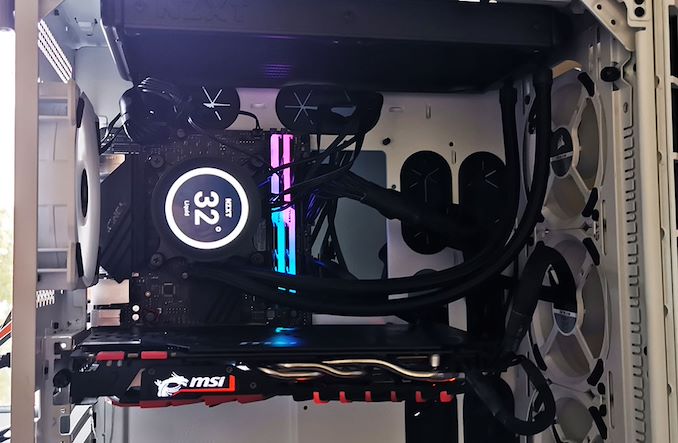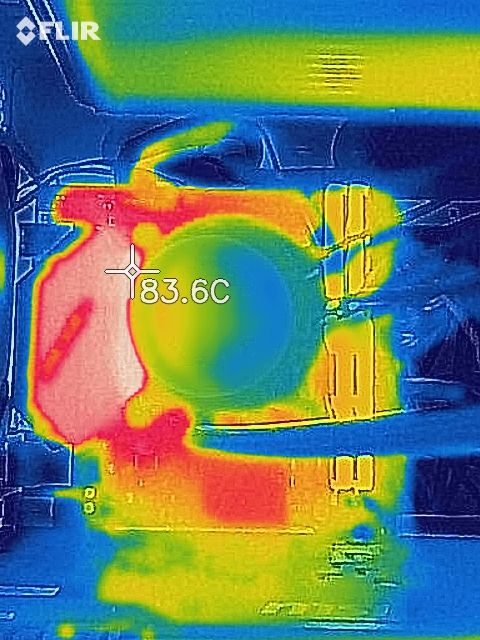The Biostar Racing Z490GTN Review: $200 for Comet Lake mini-ITX
by Dr. Ian Cutress & Gavin Bonshor on June 5, 2020 10:00 AM EST- Posted in
- Motherboards
- Intel
- Biostar
- Z490
- 10th Gen Core
- Comet Lake
- Z490GTN
Power Delivery Thermal Analysis
A lot more focus has been put onto power delivery specifications and capabilities, not just by manufacturers, but as a result of users demands. In addition to the extra power benefits from things like overclocking, more efficient designs in power deliveries and cooling solutions aim to bring temperatures down. Although this isn't something most users ever need to worry about, certain enthusiasts are bringing more focus onto each boards power delivery. The more premium models tend to include bigger and higher-grade power deliveries, with bigger and more intricate heatsink designs, with some even providing water blocks on ranges such as the ASUS ROG Maximus Formula series.

The 6+2 power delivery on the Biostar Racing Z490GTN
Testing Methodology
Our method of testing out if the power delivery and its heatsink are effective at dissipating heat, is by running an intensely heavy CPU workload for a prolonged method of time. We apply an overclock which is deemed safe and at the maximum that the silicon on our testbed processor allows. We then run the Prime95 with AVX2 enabled under a torture test for an hour at the maximum stable overclock we can which puts insane pressure on the processor. We collect our data via three different methods which include the following:
- Taking a thermal image from a birds-eye view after an hour with a Flir Pro thermal imaging camera
- Securing two probes on to the rear of the PCB, right underneath CPU VCore section of the power delivery for better parity in case a probe reports a faulty reading
- Taking a reading of the VRM temperature from the sensor reading within the HWInfo monitoring application
The reason for using three different methods is that some sensors can read inaccurate temperatures, which can give very erratic results for users looking to gauge whether an overclock is too much pressure for the power delivery handle. With using a probe on the rear, it can also show the efficiency of the power stages and heatsinks as a wide margin between the probe and sensor temperature can show that the heatsink is dissipating heat and that the design is working, or that the internal sensor is massively wrong. To ensure our probe was accurate before testing, I binned 10 and selected the most accurate (within 1c of the actual temperature) for better parity in our testing.
To recreate a real-world testing scenario, the system is built into a conventional desktop chassis which is widely available. This is to show and alleviate issues when testing on open testbeds which we have done previously, which allows natural airflow to flow over the power delivery heatsinks. It provides a better comparison for the end-user and allows us to mitigate issues where heatsinks have been designed with airflow in mind, and those that have not. The idea of a heatsink is to allow effective dissipation of heat and not act as an insulator, with much more focus from consumers over the last couple of years on power delivery componentry and performance than in previous years.

Biostar Racing Z490GTN undergoing our VRM thermal testing (We close the window during testing)
For thermal image, we use a Flir One camera as it gives a good indication of where the heat is generated around the socket area, as some designs use different configurations and an evenly spread power delivery with good components will usually generate less heat. Manufacturers who use inefficient heatsinks and cheap out on power delivery components should run hotter than those who have invested. Of course, a $700 flagship motherboard is likely to outperform a cheaper $100 model under the same testing conditions, but it is still worth testing to see which vendors are doing things correctly.
Thermal Analysis Results

We measured 83.6°C on the hottest part of the PCB around the power delivery
The Biostar Racing Z490GTN is using a 6+2 power delivery with an ON Semiconductor PCP81229 PWM controller operating at its advertised configuration. It is using ON Semiconductor NCP302155 55 A power stages across both the CPU and SoC phases, with a metal heatsink which doubles up as a rear panel cover. This heatsink only covers the six NCP302155 power stages for the CPU, while the SoC area remains at the whim of natural airflow when installed within a chassis.
Opting for a more real-world scenario than our traditional methods on an open test bench, we found that the Biostar Racing Z490GTN power delivery to run quite a bit warmer than other models on test. A couple of reasons include the boards small mini-ITX form factor, as well as a basic heatsink with not much in the way of mass. It does, however, perform well within the rated spec of the componentry. Although our testing was done on a Core i7-10700K 8-core 16-thread processor, the power delivery is likely to run extremely hot with the Core i9-10900K and we wouldn't recommend taking the risk in pairing up this board with that CPU unless it wasn't going to be pushed beyond reasonable limits.
We observed temperatures of 84°C on our first probe, and 79°C on our second, with a very hot PCB around the CPU socket which we saw 83.6°C using our FLIR thermal imaging camera. We also had to transpose our NZXT Kraken Z63 CPU cooler as the memory wouldn't allow us to install it with the screen mounted horizontally. Overall as we've stated, the temperatures noted remain within the operating specs, but we wouldn't recommend pushing further due to the heat generated.











40 Comments
View All Comments
YB1064 - Friday, June 5, 2020 - link
$200 for this board is ridiculous.boredsysadmin - Friday, June 5, 2020 - link
100%. Since when $200 is a "budget" price point for a motherboard????shabby - Friday, June 5, 2020 - link
The itx crowd will pay don't worry.HardwareDufus - Friday, June 5, 2020 - link
no we won't pay for it.1 m.2 port, no wifi, no dp, no optical audio... sorry... expensive and incomplete.
shabby - Friday, June 5, 2020 - link
Oh you'll pay and you'll like it! 😂Samus - Saturday, June 6, 2020 - link
It isn't terrible for $200 but the little things like skimping on the audio codec (that couldn't have saved more than a dollar or two, right?) really sour an ITX board when you consider there is no way to upgrade it outside of a USB DAC (which is fine for most applications, but another expense.)I purchased an Asrock Z97 ITX board a few years ago for $115 bucks at Microcenter. This is the modern day equivalent for almost double the price. To add insult to injury, the Asrock board DID have an ALC1150 codec AND 802.11ac included.
Why are motherboards getting so expensive when the chipsets and component costs are becoming simpler and less expensive?
Ej24 - Sunday, June 7, 2020 - link
Was going to say the same thing. I have 3 Z97 itx motherboards. All purchased brand new for $120. What is going on? Inflation hasn't been THAT crazy to nearly double costs. Tariffs perhaps?Samus - Monday, June 8, 2020 - link
It could actually be tariffs...this is a new trend that started after the 100 series chipsets. Even AMD boards cost a small fortune now, even more ridiculous since the chipset is almost entirely in the CPU. The board is little more than voltage regulation, tracing and connectors...alicebcao75 - Monday, June 8, 2020 - link
Make 6150 bucks every month… Start doing online computer-based work through our website. I have been working from home for 4 years now and I love it. I don’t have a boss standing over my shoulder and I make my own hours. The tips below are very informative and anyone currently working from home or planning to in the future could use this website. WWW. iⅭash68.ⅭOⅯFamous12 - Monday, September 21, 2020 - link
https://customerfeedback.onl/Share your visit experience at www.Shoecarnival.com/Feedback & grab the Chance to Win a $200 Shoe Carnival Gift Card by entering into Shoe Carnival Sweepstake.